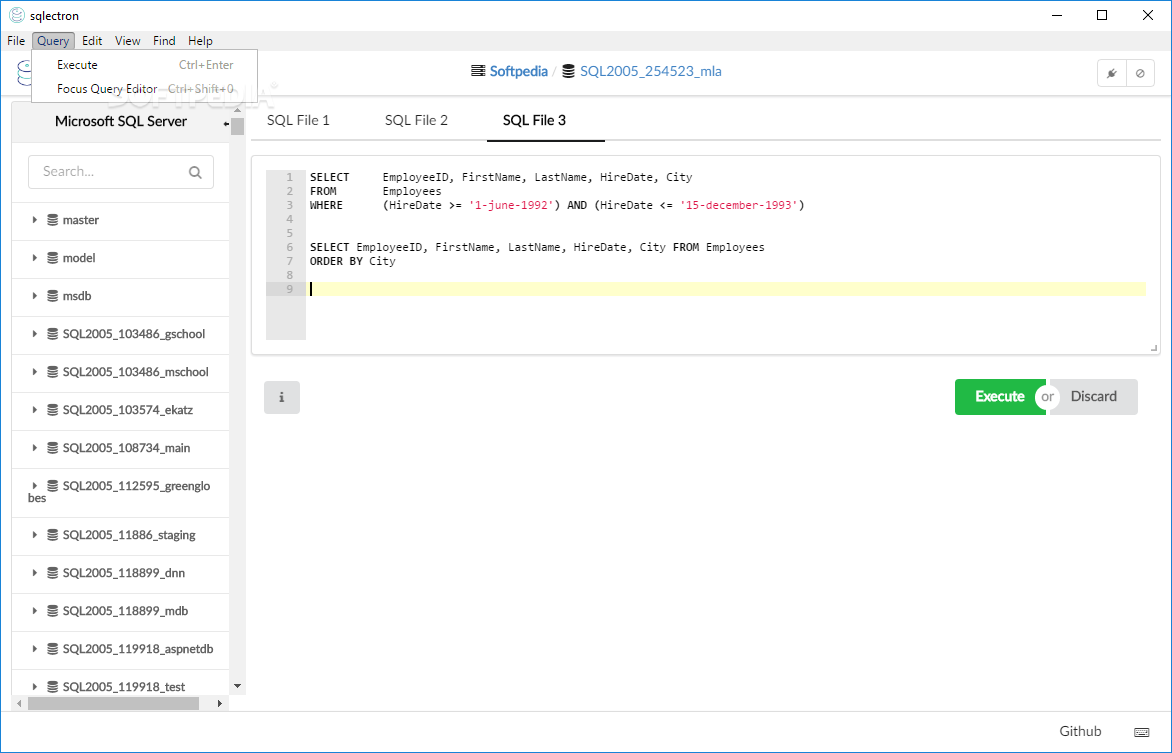


If you specify an empty file name '', the statement creates a temporary file-backed database. You can attach multiple in-memory databases at the same time with a condition that each memory database must be unique. In case you want to create a new memory database and attach it to the current database connection, you use :memory: filename. For example, to refer to the people table in the contacts database, you use the contacts.people. Once the additional database attached, you can refer to all objects in the database under the name database_name. If the database file file_name does not exist, the statement creates a new database file. The statement associates the database file file_name with the current database connection under the logical database name database_name.
SQLECTRON UPDATE CODE
Alternately, you can download Microsoft's native GUI client for Linux (and Windows & Mac), Azure Data Studio, here.ATTACH DATABASE file_name AS database_name Code language: SQL (Structured Query Language) ( sql ) Just an FYI, you can use SQL Server Management Studio to connect to SQL Server on Linux, if that's your desire. Once you have connected to the instance, you may want to configure a non-sa account. I would leave the domain and unix socket path blank.
SQLECTRON UPDATE PASSWORD
Use sa as the login, and the password you specified during SQL Server setup via the sudo /opt/mssql/bin/mssql-conf setup command. Ensure the firewall on the Linux box is allowing outside connections via 1433, if you intend to connect to SQL Server via the network. The default port for SQL Server is 1433 - unless you chose a different port in mssql-conf use that port number. In the output above, the bit that is important is the "inet" address, which in my case is 192.168.200.11. TX errors 0 dropped 0 overruns 0 carrier 0 collisions 0 You can obtain that by running ifconfig from a Linux terminal prompt. If you are running the GUI from a different workstation, you'll need the IPv4 address of the machine where the mssql-server service is running. Selectron CAP1131 s’exécute sur les systèmes d’exploitation suivants : Windows. Au départ, il a été ajouté à notre base de données sur. La dernière version de Selectron CAP1131 est actuellement inconnue. If you are running the GUI on the same machine as the mssql-server service, then you can use localhost for the address (127.0.0.1). Selectron CAP1131 est un logiciel de Shareware dans la catégorie Divers développé par Selectron Systems AG. How do I find the server name, host address (127.0.0.1?), port, domain, Unix socket path and username? The only one I know of is the password which I set in the sudo /opt/mssql/bin/mssql-conf setup command. I am now attempting to create a local connection to my server through SQLectron on the following screen:Īs I have very little experience with SQL Servers, I am completely lost with where to get all of these credentials to connect to my local server. Loaded: loaded (/usr/lib/systemd/system/rvice enabled vendor preset: disabled)Īctive: active (running) since Wed 13:43:49 IST 2h 42min agoĬGroup: /system.slice/rviceĪug 23 13:43:52 XPS-Manjaro sqlservr: Īug 23 13:49:03 XPS-Manjaro sqlservr: Īug 23 13:52:31 XPS-Manjaro sqlservr: rvice - Microsoft SQL Server Database Engine.After doing so, running the command systemctl status mssql-server returns this: ~]$ systemctl status mssql-server I have run the sudo /opt/mssql/bin/mssql-conf setup command in order to (I believe) set up a local server. So far I have installed mssql-server, mssql-tools and sqlectron-gui.
SQLECTRON UPDATE INSTALL
I am using Manjaro Linux and so install my packages from the AUR. I would like to create a local SQL Server instance on the machine, and then use SQLectron as a GUI client for querying my database. I am now trying to achieve a similar setup on a Linux machine. I have recently been using SQL Server Express and accessing my database using SQL Server Management Studio on Windows. I am very new to SQL and database servers.


 0 kommentar(er)
0 kommentar(er)
